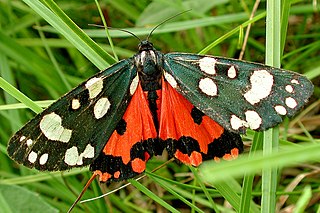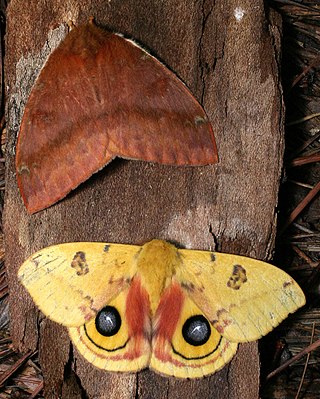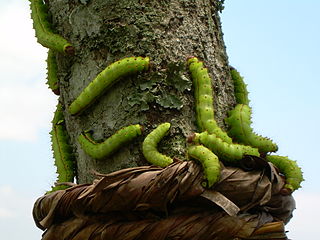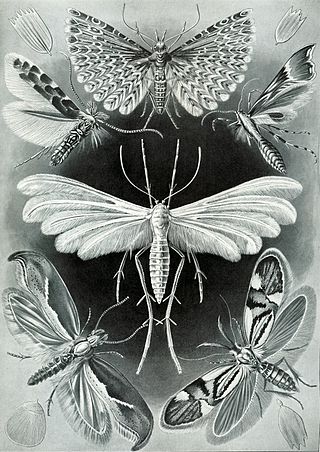
Entomology is the scientific study of insects, a branch of zoology. In the past the term "insect" was less specific, and historically the definition of entomology would also include the study of animals in other arthropod groups, such as arachnids, myriapods, and crustaceans. This wider meaning may still be encountered in informal use.
Michael Eugene Nicolas Majerus was a British geneticist and professor of evolution at the University of Cambridge. He was also a teaching fellow at Clare College, Cambridge. He was an enthusiast in Darwin's theory of evolution by natural selection and became a world authority in his field of insect evolutionary biology. He was widely noted for his work on moths and ladybirds and as an advocate of the science of evolution. He was also an enthusiastic educator and the author of several books on insects, evolution and sexual reproduction. He is best remembered as an ardent supporter and champion of experiments on peppered moth evolution.

The scarlet tiger moth is a colorful moth belonging to the tiger moth subfamily, Arctiinae. The species was first described by Carl Linnaeus in his 1758 10th edition of Systema Naturae.

Charles Oberthür was a French amateur entomologist specializing in lepidoptera.

Automeris io, the Io moth or peacock moth, is a colorful North American moth in the family Saturniidae. The io moth is also a member of the subfamily Hemileucinae. The name Io comes from Greek mythology in which Io was a mortal lover of Zeus. The Io moth ranges from the southeast corner of Manitoba and in the southern extremes of Ontario, Quebec, New Brunswick and Nova Scotia in Canada, and in the US it is found from Montana, North Dakota, South Dakota, Nebraska, Colorado, New Mexico, Texas, Utah, east of those states and down to the southern end of Florida. The species was first described by Johan Christian Fabricius in 1775.

Anthophila fabriciana, also known as the common nettle-tap, is a moth of the family Choreutidae first described in 1767 by Carl Linnaeus. The moth can be found flying around stinging nettles during the day.

Wild silks have been known and used in many countries from early times, although the scale of production is far smaller than that from cultivated silkworms. Silk cocoons and nests often resemble paper or cloth, and their use has arisen independently in many societies.

Grotella harveyi is a species of moth in the genus Grotella, of the family Noctuidae. This moth species is found in North America, including Colorado, its type location.
BugGuide is a website and online community of naturalists, both amateur and professional, who share observations of arthropods such as insects, spiders, and other related creatures. The website consists of informational guide pages and many thousands of photographs of arthropods from the United States and Canada which are used for identification and research. The non-commercial site is hosted by the Iowa State University Department of Entomology. BugGuide was conceived by photographer Troy Bartlett in 2003 and since 2006 has been maintained by John VanDyk, an adjunct assistant professor of entomology and a senior systems analyst at Iowa State University. The website has been recognized for helping change public perception of insects.

Automeris is a genus of moths in the family Saturniidae and the subfamily Hemileucinae. As of 1996 there were 124 species, and more have since been described. These moths are generally characterized by the eyelike patches on the hindwings and the leaflike pattern on the forewings, an example of crypsis. The genus was first described by Jacob Hübner in 1819 and it is distributed in the Neotropical realm.

Annette Frances Braun (1884–1978) was an American entomologist and leading authority on microlepidoptera, a grouping of mostly small and nocturnal moths. Her special interest was leaf miners: moths whose larvae live and feed from within a leaf.
Nemoria rubrifrontaria, the red-fronted emerald, is a species of moth in the family Geometridae, in the superfamily Geometroidea. The species was described by Alpheus Spring Packard in 1873. It is found in North America.
Automeris randa, Rand's eyed silk moth, is a species of buck and io moths in the family Saturniidae. It was described by Herbert Druce in 1894 and is found in Central and North America.
Automeris louisiana, the Louisiana eyed silkmoth, is a species of moth in the family Saturniidae. It is found in North America.
Automeris zephyria, the zephyr eyed silkmoth, is a species of insect in the family Saturniidae. It is found in North America.
Automeris cecrops, the cecrops eyed silkmoth, is a species of insect in the family Saturniidae. It is found in Central America and North America.
Automeris patagoniensis, the Patagonia eyed silkmoth, is a species of insect in the family Saturniidae. It is found in North America.
Automeris iris, the iris eyed silkmoth, is a species of insect in the family Saturniidae. It is found in Central America and North America.
Robert F. Sternitzky was a United States lepidopterist and illustrator. Butterfly and moth specimens he collected are in a number of collections, including those of the Harvard Museum of Natural History, the Essig Museum of Entomology, Manitoba Museum, and the Smithsonian National Museum of Natural History. He collected primarily in California and Arizona.

Automeris curvilinea is a species from the genus Automeris. The species was originally described in 1906 by William Schaus.










